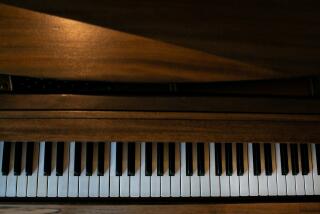Music Lessons
- Share via
How did you learn your multiplication tables, grammar rules and the state capitals? Chances are it was through drill: rote memorization, repeated writing.
But a Newport Beach couple argues that there is an easier and more entertaining method of learning basic facts--singing. Kathy and Larry Troxel have entered the business of educational music tapes, a growing field with half a dozen competitors as teachers try different ways of getting kids to learn information.
*
I’m running, jumping, singing--that’s because I am a verb.
I’m hopping, dancing, ringing--that’s because I am a verb.
I’m coming, going, hitting, throwing
--From “The Verb Song,” on the “Grammar Songs” cassette
*
In 1979, Kathy Troxel, then a high school English teacher in the Long Beach Unified School District, said she was appalled to learn that her 10th-graders couldn’t explain the difference between adjectives and adverbs, nouns and verbs.
Convinced that you learn more quickly and retain more with music, she invented a rhyme using the Beach Boys song, “California Girls.” By 1984, she had quit teaching and started Audio Memory. Last year, the company sold 24,366 cassettes.
The company, which operates out of the Troxel home, sells eight cassettes of original songs that drill the fundamentals of math, grammar, vocabulary and geography. Cassettes cost $9.95 or $19.95. The jingles are reinforced with a workbook of written exercises and copies of the lyrics.
The songs, with music by Larry and words by Kathy, don’t try to teach complicated subjects or issues open to debate. Here, it’s just the basics, repeated and set to music.
“If you don’t have that foundation, you can’t really apply it at a higher level,” Kathy Troxel said.
Who didn’t learn the alphabet by singing the ABC song? And children in the 1970s watched Schoolhouse Rock, the televised cartoon set to rock music to find out about the parts of speech and the three branches of government.
Elaine Weiner, a teacher at Allen Elementary School in the Garden Grove Unified School District, has used Troxel’s grammar cassette to teach her students grammar for more than a decade. When they master the basics, she begins lessons on diagramming sentences.
“I’ll ask them questions and they’ll stop and think and I’ll hear them sing the songs,” Weiner said.
A relationship between music and the brain is not new. The brain has a natural ability to look for patterns of information, such as music or rhymes, and “certain patterns are more conducive to remembering,” said Gordon Shaw, a UC Irvine physics professor who studies these issues.
Educators too are convinced of a link between music and memory, said Phyllis Berenbeim, the coordinator of visual and performing arts programs at the Orange County Department of Education, even though she conceded that no formal studies have addressed the issue.
“Personally I think it’s a good thing,” she said. “The repetition, the rhythm, the melody, seem to engage the whole child.
“We know that teachers should be using as many different tools--such as music--to make learning meaningful.”
That is why Fama Nelson, a fourth-grade teacher at Maranatha Christian Academy in Costa Mesa, has been using “Grammar Songs” for four or five years.
“It’s another way to learn,” she said, “and any time you can do something in a fun way and [the students] are still learning, you should do it.”
I’m a verb, verb, verb--I’m an action word.
So put me where the action is ‘cause I’m an action word.
Audio Memory learning cassettes have a following in Christian schools and among home-school advocates, because of occasional references to God or the Bible found in a few of the written exercises that accompany the tapes.
Outside classroom settings, parents buy the Troxels’ tapes and other brands to supplement what’s being taught in schools, especially in subject areas where a child is struggling.
“We sell a lot of the math tapes,” said Gregg Colbert, the owner of The School Shop, an educational materials store in Costa Mesa that has a large selection of learning cassettes.
“Parents say [their children] are having trouble with math and they’re looking for outside resources.”
Troxel’s tapes are geared for students from second to eighth grades. Older kids won’t feel “cool” singing the songs, she said, and younger children won’t understand most of it.
(BEGIN TEXT OF INFOBOX / INFOGRAPHIC)
Breaking Into Song
If you and your child are trapped inside the house on a rainy day or have a long car ride ahead of you, here are a few ways you can engage your child with an educational song:
* Use an existing song or nursery rhyme your child already knows, such as “This Old Man,” “Happy Birthday” or “Twinkle, Twinkle Little Star.”
* Have your child suggest a song topic so you know it’s something he or she will be interested in.
* Other ideas for songs include difficult spelling words, cities in Orange County, basic Spanish.
* Ask your child to help you with the lyrics and to even write some independently so he or she will remain engaged.
* Have your child clap the rhythm so he or she will understand how the words fit into a pattern.
More to Read
Sign up for Essential California
The most important California stories and recommendations in your inbox every morning.
You may occasionally receive promotional content from the Los Angeles Times.













